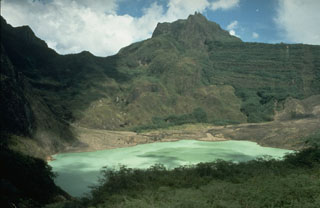Report on Kelud (Indonesia) — July 2008
Bulletin of the Global Volcanism Network, vol. 33, no. 7 (July 2008)
Managing Editor: Richard Wunderman.
Kelud (Indonesia) Lava dome reached 35 million cubic meters; eruptions ceased in mid-May
Please cite this report as:
Global Volcanism Program, 2008. Report on Kelud (Indonesia) (Wunderman, R., ed.). Bulletin of the Global Volcanism Network, 33:7. Smithsonian Institution. https://doi.org/10.5479/si.GVP.BGVN200807-263280
Kelud
Indonesia
7.935°S, 112.314°E; summit elev. 1730 m
All times are local (unless otherwise noted)
According to Alain Bernard, the lava dome that extruded in late 2007 (BGVN 33:03) continued to increase in size until it covered much of the crater lake and it rose to overwhelm the drainage inlets. Bernard noted that dome growth had seemingly ceased by April 2008. Around that time (but at unstated date), VSI made initial estimates of the dome's dimensions as 200 m high, 400 m wide, with a volume of 35 x 106 m3.
The lake was almost gone by the middle of May 2008. The temperature of flow of waters at the end of the drainage tunnel (~ 960 m away from the dome) has been reported to be higher than in the crater lake, 66.7°C. Both phreatic and magmatic degassing was very minor. A very small amount of ash was emitted, and there were no lahars
On 12 May 2008, the eruption status was downgraded to Green, a level indicating that either no significant eruption is expected or that fewer than 100,000 people within 100 km of the volcano would be affected by activity.
Geological Summary. The relatively inconspicuous Kelud stratovolcano contains a summit crater lake that has been the source of some of Indonesia's most deadly eruptions. A cluster of summit lava domes cut by numerous craters has given the summit a very irregular profile. Satellitic cones and lava domes are also located low on the E, W, and SSW flanks. Eruptive activity has in general migrated in a clockwise direction around the summit vent complex. More than 30 eruptions have been recorded since 1000 CE. The ejection of water from the crater lake during the typically short but violent eruptions has created pyroclastic flows and lahars that have caused widespread fatalities and destruction. After more than 5,000 people were killed during an eruption in 1919, an engineering project to drain the crater lake lowered the surface by more than 50 m. The 1951 eruption deepened the crater by 70 m, leaving 50 million cubic meters of water after the damaged drainage tunnels were repaired. Following more than 200 deaths in the 1966 eruption, a new deeper tunnel was constructed, and the lake's volume before the 1990 eruption was only about 1 million cubic meters.
Information Contacts: Alain Bernard, Free University of Brussels, CP 160/02, 50, avenue F, Roosevelt, 1050 Brussels, Belgium (URL: http://www.ulb.ac.be/sciences/cvl/); Volcanological Survey of Indonesia, Center of Volcanology and Geological Hazard Mitigation, Saut Simatupang, 57, Bandung 40122, Indonesia (URL: http://vsi.esdm.go.id/).

